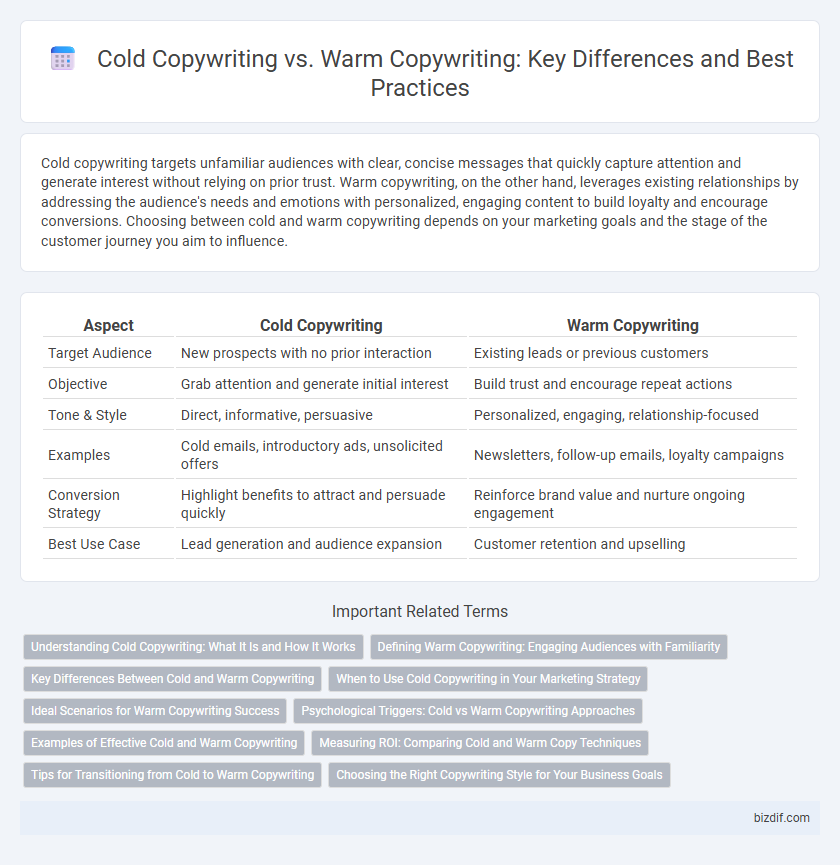Cold copywriting targets unfamiliar audiences with clear, concise messages that quickly capture attention and generate interest without relying on prior trust. Warm copywriting, on the other hand, leverages existing relationships by addressing the audience's needs and emotions with personalized, engaging content to build loyalty and encourage conversions. Choosing between cold and warm copywriting depends on your marketing goals and the stage of the customer journey you aim to influence.
Table of Comparison
| Aspect | Cold Copywriting | Warm Copywriting |
|---|---|---|
| Target Audience | New prospects with no prior interaction | Existing leads or previous customers |
| Objective | Grab attention and generate initial interest | Build trust and encourage repeat actions |
| Tone & Style | Direct, informative, persuasive | Personalized, engaging, relationship-focused |
| Examples | Cold emails, introductory ads, unsolicited offers | Newsletters, follow-up emails, loyalty campaigns |
| Conversion Strategy | Highlight benefits to attract and persuade quickly | Reinforce brand value and nurture ongoing engagement |
| Best Use Case | Lead generation and audience expansion | Customer retention and upselling |
Understanding Cold Copywriting: What It Is and How It Works
Cold copywriting targets unfamiliar audiences who have little to no prior interaction with a brand, aiming to capture attention and spark interest through compelling headlines and clear value propositions. This approach relies heavily on persuasive language and emotional triggers to overcome skepticism and build initial trust quickly. Effective cold copywriting combines market research and targeted messaging to convert strangers into prospects.
Defining Warm Copywriting: Engaging Audiences with Familiarity
Warm copywriting leverages existing relationships and familiarity to create personalized, empathetic messages that resonate deeply with target audiences. By using language that reflects shared experiences and building trust through approachable tone, warm copywriting enhances engagement and conversion rates. This strategy often incorporates customer insights and emotional triggers to foster loyalty and long-term brand affinity.
Key Differences Between Cold and Warm Copywriting
Cold copywriting targets unfamiliar audiences, emphasizing attention-grabbing headlines and concise, persuasive language to spark initial interest. Warm copywriting addresses engaged prospects, leveraging personalized content and trust-building narratives to nurture relationships and encourage conversions. The key differences lie in audience familiarity, tone, and the strategic use of emotional appeal to either initiate contact or deepen engagement.
When to Use Cold Copywriting in Your Marketing Strategy
Cold copywriting is most effective when targeting audiences unfamiliar with your brand, aiming to generate initial awareness and spark interest. It works well in lead generation campaigns, outreach emails, and social media ads designed to attract new prospects. Employ cold copywriting early in the marketing funnel to introduce products or services and build a foundation for further engagement.
Ideal Scenarios for Warm Copywriting Success
Warm copywriting excels in scenarios where the audience is already familiar with the brand, such as retargeting campaigns, email newsletters to existing subscribers, and loyalty programs. It capitalizes on established trust and emotional connections, increasing the likelihood of conversions through personalized messaging. This approach is most effective for nurturing leads, boosting customer retention, and driving repeat sales.
Psychological Triggers: Cold vs Warm Copywriting Approaches
Cold copywriting relies heavily on psychological triggers such as curiosity, fear of missing out (FOMO), and urgency to capture attention from an audience with little prior engagement. Warm copywriting leverages trust, social proof, and reciprocity by targeting an audience already familiar with the brand, fostering deeper emotional connections and increasing conversion potential. Understanding these distinct triggers enables marketers to tailor messaging strategies effectively for different stages of the customer journey.
Examples of Effective Cold and Warm Copywriting
Cold copywriting often includes direct calls-to-action and clear value propositions, such as "Unlock 50% savings on your first order--shop now!" Warm copywriting utilizes storytelling and emotional appeal, for example, "Join thousands of happy customers who transformed their mornings with our organic coffee blend." Both styles effectively engage audiences by addressing different stages of the buyer's journey and emotional triggers.
Measuring ROI: Comparing Cold and Warm Copy Techniques
Measuring ROI in cold copywriting requires analyzing response rates and customer acquisition costs, often revealing lower immediate returns due to less personalized messaging. Warm copywriting tends to yield higher conversion rates and stronger customer lifetime value by leveraging prior engagement and tailored content. Businesses maximize ROI by integrating data-driven insights to refine cold and warm copy strategies according to target audience behavior.
Tips for Transitioning from Cold to Warm Copywriting
Transitioning from cold to warm copywriting requires understanding your audience's pain points and building rapport through personalized messaging that resonates emotionally. Employ storytelling techniques and social proof such as testimonials to create trust and credibility, transforming neutral leads into engaged prospects. Gradually incorporate conversational language and empathetic tone to foster connection and encourage action from your audience.
Choosing the Right Copywriting Style for Your Business Goals
Cold copywriting targets prospects unfamiliar with your brand, using clear, persuasive language to spark initial interest and build trust gradually. Warm copywriting engages an already interested audience by emphasizing relationship-building, personalized messaging, and reinforcing brand value to drive conversions. Selecting the right style depends on your business goals, audience maturity, and sales funnel stage, ensuring messages resonate effectively and optimize ROI.
Cold Copywriting vs Warm Copywriting Infographic

 bizdif.com
bizdif.com